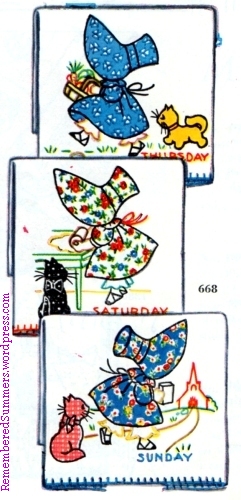Once upon a time, certain days of the week were devoted to specific tasks, and there was a general agreement among housewives that Monday was Laundry Day. On Tuesday, you did the ironing. Wednesday, you could recover from those backbreaking jobs by sewing, mending, and knitting — at least that work could be done while you were sitting down.
Thursday was usually ” Go to Market” day; on Friday you cleaned the house.
On Saturday, you baked for the weekend, since Sunday was “the Day of Rest” (and the day for church attendance.)
These day-of-the-week and job-of-the-day patterns had long been popular for use on dish towels, since you needed a fresh towel every day. It may seem incredible that a housewife’s tasks should be so regimented, but there were good reasons.
Laundry Day
Doing the laundry took all day, starting with rising extra-early to build a fire and start heating wash water; you had to get the laundry on the line early, too, if you wanted it to dry before dark. There were no electric or gas dryers in most homes until the 1950s. Laundry had to be hung out to dry in your yard, in fresh air, which meant that it was exposed to public view. Most back yards contained two tall posts (picture small, square telephone poles) with four or more clotheslines strung between them from the crossbars. (Wet sheets took up a lot of room.) For the benefit of people who have never dried their laundry this way, here are some prettified versions of what more compact clotheslines looked like in the twenties and thirties:
I had a folding laundry line like this one in my back yard in the 1970s, and I have a friend who still uses one, because sheets that have been dried in fresh air just smell better than any artificial fragrance on a dryer sheet.
It seems incredible that proof of cleanliness is now forbidden as unsightly in some (energy wasting) communities. Incidentally, we still use the expressions “hung out to dry” and “clotheslined,” which have a very literal meaning to people born before 1960. (Walking into an empty clothesline in the dark meant it caught you under the chin and left you lying flat on the ground.)
Of course, in the old days, all of your neighbors hung out laundry on the same day you did, so there was some competition as to who had the whitest sheets. In the 1940s , my grandmother always put bluing in her final rinse.
I am still using embroidered dishtowels that I inherited thirty years ago — and they were already old then. I love them, because the embroidery was done on bleached feed sacks, so they are large enough to surround big pots and pans and prevent drips while you dry them, and, after hundreds of washings, they are very soft and absorbent!
Apparently my aunt had two sets made from the same pattern, since two of her “Thursday — Go to Market” towels are still around:
Tuesday: Ironing Day
At first I thought Sunbonnet Sue was holding an iron, but the Tuesday “iron” towels from this set had a visible ironing board, like these:
It was vital to iron on Tuesday in case the wash did not get completely dry on Monday. By Wednesday it would be wrinkled and possibly starting to mildew.
In addition to variations on the Sunbonnet Sue quilt motif, McCall’s was licensed to carry Raggedy Ann embroidery patterns and doll patterns.

Pattern for Raggedy Ann and Andy Dolls, McCall’s 820, 1950. This pattern must have been available earlier, because I got a homemade doll like this around 1947.
Little Lulu, a comic book character, also starred in a set of McCall’s towel patterns. There’s a copyright licensing mark at the bottom of the ad:
Embroidered kitchen towels were often made as gifts, and a set of seven was a very useful housewarming present, but I think my aunt purchased hers at various “charity bazaars” or other fund-raising events. I’m glad she did!
Some patterns disagreed about whether baking and marketing should be done on Saturday and Thursday, respectively; perhaps some towns held their market day on Saturday. In the fifties, my grandmother did her main shopping on Saturday, when my uncle could drive her to the supermarket, but she always baked pies and tarts for the week on Saturday afternoon. If I had a time machine, I’d book a visit to Grandma’s pantry, fragrant with baked goods, on any Saturday afternoon in 1949. Of course, it would be even nicer if she were there . . . .











Pingback: How to Do Laundry, 1920’s and Later (Part 1) | witness2fashion
Thank you so much for your great article. I am retire and was told to get a daily schedule. I procrastinate and accomplish little. I decide I would do like women of the past. Though I don’t iron clothes, I do Quilt and will use Tuesdays to press my material and Quilt tops for sewing and long arm Quilt ing.
I, too, am retired and having trouble getting things done, because it’s so easy to say “I’ll do it tomorrow” when my deadlines are all arbitrary and self-imposed. The “days of the week” answer was staring me in the face! And you’re right, I don’t need to iron very often, so that can be a day for other pursuits. Thanks!
Goodness gracious, thank you for this information. Back in the 1960s in London, I had a doll called Raggedy Ann. I just thought that was her name, it has made my day to see her face again today. Have a nice week 🙂